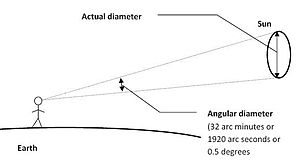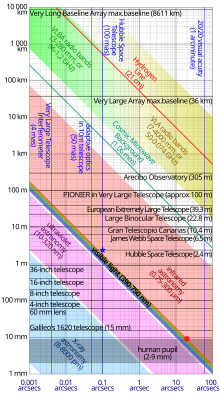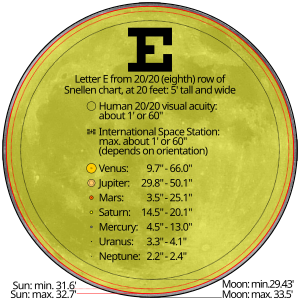Angular diameter
This article needs additional citations for verification. (September 2009) |

The angular diameter, angular size, apparent diameter, or apparent size is an angular distance describing how large a sphere or circle appears from a given point of view. In the vision sciences, it is called the visual angle, and in optics, it is the angular aperture (of a lens). The angular diameter can alternatively be thought of as the angular displacement through which an eye or camera must rotate to look from one side of an apparent circle to the opposite side. Humans can resolve with their naked eyes diameters down to about 1 arcminute (approximately 0.017° or 0.0003 radians).[1] This corresponds to 0.3 m at a 1 km distance, or to perceiving Venus as a disk under optimal conditions.
Formula
[edit]
The angular diameter of a circle whose plane is perpendicular to the displacement vector between the point of view and the center of said circle can be calculated using the formula[2][3]
in which is the angular diameter in degrees, and is the actual diameter of the object, and is the distance to the object. When , we have ,[4] and the result obtained is in radians.
For a spherical object whose actual diameter equals and where is the distance to the center of the sphere, the angular diameter can be found by the following modified formula[citation needed]
The difference is due to the fact that the apparent edges of a sphere are its tangent points, which are closer to the observer than the center of the sphere, and have a distance between them which is smaller than the actual diameter. The above formula can be found by understanding that in the case of a spherical object, a right triangle can be constructed such that its three vertices are the observer, the center of the sphere, and one of the sphere's tangent points, with as the hypotenuse and as the sine.[citation needed]
The difference is significant only for spherical objects of large angular diameter, since the following small-angle approximations hold for small values of :[5]
Estimating angular diameter using the hand
[edit]
Estimates of angular diameter may be obtained by holding the hand at right angles to a fully extended arm, as shown in the figure.[6][7][8]
Use in astronomy
[edit]
In astronomy, the sizes of celestial objects are often given in terms of their angular diameter as seen from Earth, rather than their actual sizes. Since these angular diameters are typically small, it is common to present them in arcseconds (″). An arcsecond is 1/3600th of one degree (1°) and a radian is 180/π degrees. So one radian equals 3,600 × 180/ arcseconds, which is about 206,265 arcseconds (1 rad ≈ 206,264.806247"). Therefore, the angular diameter of an object with physical diameter d at a distance D, expressed in arcseconds, is given by:[9]
- .
These objects have an angular diameter of 1″:
- an object of diameter 1 cm at a distance of 2.06 km
- an object of diameter 725.27 km at a distance of 1 astronomical unit (AU)
- an object of diameter 45 866 916 km at 1 light-year
- an object of diameter 1 AU (149 597 871 km) at a distance of 1 parsec (pc)
Thus, the angular diameter of Earth's orbit around the Sun as viewed from a distance of 1 pc is 2″, as 1 AU is the mean radius of Earth's orbit.
The angular diameter of the Sun, from a distance of one light-year, is 0.03″, and that of Earth 0.0003″. The angular diameter 0.03″ of the Sun given above is approximately the same as that of a human body at a distance of the diameter of Earth.
This table shows the angular sizes of noteworthy celestial bodies as seen from Earth:
| Celestial object | Angular diameter or size | Relative size |
|---|---|---|
| Magellanic Stream | over 100° | |
| Gum Nebula | 36° | |
| Milky Way | 30° (by 360°) | |
| Width of spread out hand with arm stretched out | 20° | 353 meter at 1 km distance |
| Serpens-Aquila Rift | 20° by 10° | |
| Canis Major Overdensity | 12° by 12° | |
| Smith's Cloud | 11° | |
| Large Magellanic Cloud | 10.75° by 9.17° | Note: brightest galaxy, other than the Milky Way, in the night sky (0.9 apparent magnitude (V)) |
| Barnard's loop | 10° | |
| Zeta Ophiuchi Sh2-27 nebula | 10° | |
| Width of fist with arm stretched out | 10° | 175 meter at 1 km distance |
| Sagittarius Dwarf Spheroidal Galaxy | 7.5° by 3.6° | |
| Northern Coalsack Nebula | 7° by 5°[10] | |
| Coalsack nebula | 7° by 5° | |
| Cygnus OB7 | 4° by 7°[11] | |
| Rho Ophiuchi cloud complex | 4.5° by 6.5° | |
| Hyades | 5°30′ | Note: brightest star cluster in the night sky, 0.5 apparent magnitude (V) |
| Small Magellanic Cloud | 5°20′ by 3°5′ | |
| Andromeda Galaxy | 3°10′ by 1° | About six times the size of the Sun or the Moon. Only the much smaller core is visible without long-exposure photography. |
| Charon (from the surface of Pluto) | 3°9’ | |
| Veil Nebula | 3° | |
| Heart Nebula | 2.5° by 2.5° | |
| Westerhout 5 | 2.3° by 1.25° | |
| Sh2-54 | 2.3° | |
| Carina Nebula | 2° by 2° | Note: brightest nebula in the night sky, 1.0 apparent magnitude (V) |
| North America Nebula | 2° by 100′ | |
| Earth in the Moon's sky | 2° - 1°48′[12] | Appearing about three to four times larger than the Moon in Earth's sky |
| The Sun in the sky of Mercury | 1.15° - 1.76° | [13] |
| Orion Nebula | 1°5′ by 1° | |
| Width of little finger with arm stretched out | 1° | 17.5 meter at 1 km distance |
| The Sun in the sky of Venus | 0.7° | [13][14] |
| Io (as seen from the “surface” of Jupiter) | 35’ 35” | |
| Moon | 34′6″ – 29′20″ | 32.5–28 times the maximum value for Venus (orange bar below) / 2046–1760″ the Moon has a diameter of 3,474 km |
| Sun | 32′32″ – 31′27″ | 31–30 times the maximum value for Venus (orange bar below) / 1952–1887″ the Sun has a diameter of 1,391,400 km |
| Triton (from the “surface” of Neptune) | 28’ 11” | |
| Angular size of the distance between Earth and the Moon as viewed from Mars, at inferior conjunction | about 25′ | |
| Ariel (from the “surface” of Uranus) | 24’ 11” | |
| Ganymede (from the “surface” of Jupiter) | 18’ 6” | |
| Europa (from the “surface” of Jupiter) | 17’ 51” | |
| Umbriel (from the “surface” of Uranus) | 16’ 42” | |
| Helix Nebula | about 16′ by 28′ | |
| Jupiter if it were as close to Earth as Mars | 9.0′ – 1.2′ | |
| Spire in Eagle Nebula | 4′40″ | length is 280″ |
| Phobos as seen from Mars | 4.1′ | |
| Venus | 1′6″ – 0′9.7″ | |
| International Space Station (ISS) | 1′3″ | [15] the ISS has a width of about 108 m |
| Minimum resolvable diameter by the human eye | 1′ | [16] 0.3 meter at 1 km distance[17]
|
| About 100 km on the surface of the Moon | 1′ | Comparable to the size of features like large lunar craters, such as the Copernicus crater, a prominent bright spot in the eastern part of Oceanus Procellarum on the waning side, or the Tycho crater within a bright area in the south, of the lunar near side. |
| Jupiter | 50.1″ – 29.8″ | |
| Earth as seen from Mars | 48.2″[13] – 6.6″ | |
| Minimum resolvable gap between two lines by the human eye | 40″ | a gap of 0.026 mm as viewed from 15 cm away[16][17] |
| Mars | 25.1″ – 3.5″ | |
| Apparent size of Sun, seen from 90377 Sedna at aphelion | 20.4" | |
| Saturn | 20.1″ – 14.5″ | |
| Mercury | 13.0″ – 4.5″ | |
| Earth's Moon as seen from Mars | 13.27″ – 1.79″ | |
| Uranus | 4.1″ – 3.3″ | |
| Neptune | 2.4″ – 2.2″ | |
| Ganymede | 1.8″ – 1.2″ | Ganymede has a diameter of 5,268 km |
| An astronaut (~1.7 m) at a distance of 350 km, the average altitude of the ISS | 1″ | |
| Minimum resolvable diameter by Galileo Galilei's largest 38mm refracting telescopes | ~1″ | [18] Note: 30x[19] magnification, comparable to very strong contemporary terrestrial binoculars |
| Ceres | 0.84″ – 0.33″ | |
| Vesta | 0.64″ – 0.20″ | |
| Pluto | 0.11″ – 0.06″ | |
| Eris | 0.089″ – 0.034″ | |
| R Doradus | 0.062″ – 0.052″ | Note: R Doradus is thought to be the extrasolar star with the largest apparent size as viewed from Earth |
| Betelgeuse | 0.060″ – 0.049″ | |
| Alphard | 0.00909″ | |
| Alpha Centauri A | 0.007″ | |
| Canopus | 0.006″ | |
| Sirius | 0.005936″ | |
| Altair | 0.003″ | |
| Rho Cassiopeiae | 0.0021″[20] | |
| Deneb | 0.002″ | |
| Proxima Centauri | 0.001″ | |
| Alnitak | 0.0005″ | |
| Proxima Centauri b | 0.00008″ | |
| Event horizon of black hole M87* at center of the M87 galaxy, imaged by the Event Horizon Telescope in 2019. | 0.000025″
(2.5×10−5) |
Comparable to a tennis ball on the Moon |
| A star like Alnitak at a distance where the Hubble Space Telescope would just be able to see it[21] | 6×10−10 arcsec |



The angular diameter of the Sun, as seen from Earth, is about 250,000 times that of Sirius. (Sirius has twice the diameter and its distance is 500,000 times as much; the Sun is 1010 times as bright, corresponding to an angular diameter ratio of 105, so Sirius is roughly 6 times as bright per unit solid angle.)
The angular diameter of the Sun is also about 250,000 times that of Alpha Centauri A (it has about the same diameter and the distance is 250,000 times as much; the Sun is 4×1010 times as bright, corresponding to an angular diameter ratio of 200,000, so Alpha Centauri A is a little brighter per unit solid angle).
The angular diameter of the Sun is about the same as that of the Moon. (The Sun's diameter is 400 times as large and its distance also; the Sun is 200,000 to 500,000 times as bright as the full Moon (figures vary), corresponding to an angular diameter ratio of 450 to 700, so a celestial body with a diameter of 2.5–4″ and the same brightness per unit solid angle would have the same brightness as the full Moon.)
Even though Pluto is physically larger than Ceres, when viewed from Earth (e.g., through the Hubble Space Telescope) Ceres has a much larger apparent size.
Angular sizes measured in degrees are useful for larger patches of sky. (For example, the three stars of the Belt cover about 4.5° of angular size.) However, much finer units are needed to measure the angular sizes of galaxies, nebulae, or other objects of the night sky.
Degrees, therefore, are subdivided as follows:
- 360 degrees (°) in a full circle
- 60 arc-minutes (′) in one degree
- 60 arc-seconds (″) in one arc-minute
To put this in perspective, the full Moon as viewed from Earth is about 1⁄2°, or 30′ (or 1800″). The Moon's motion across the sky can be measured in angular size: approximately 15° every hour, or 15″ per second. A one-mile-long line painted on the face of the Moon would appear from Earth to be about 1″ in length.
In astronomy, it is typically difficult to directly measure the distance to an object, yet the object may have a known physical size (perhaps it is similar to a closer object with known distance) and a measurable angular diameter. In that case, the angular diameter formula can be inverted to yield the angular diameter distance to distant objects as
In non-Euclidean space, such as our expanding universe, the angular diameter distance is only one of several definitions of distance, so that there can be different "distances" to the same object. See Distance measures (cosmology).
Non-circular objects
[edit]Many deep-sky objects such as galaxies and nebulae appear non-circular and are thus typically given two measures of diameter: major axis and minor axis. For example, the Small Magellanic Cloud has a visual apparent diameter of 5° 20′ × 3° 5′.
Defect of illumination
[edit]Defect of illumination is the maximum angular width of the unilluminated part of a celestial body seen by a given observer. For example, if an object is 40″ of arc across and is 75% illuminated, the defect of illumination is 10″.
See also
[edit]- Angular diameter distance
- Angular resolution
- Solid angle
- Visual acuity
- Visual angle
- Perceived visual angle
- List of stars with resolved images
- Apparent magnitude
References
[edit]- ^ Yanoff, Myron; Duker, Jay S. (2009). Ophthalmology 3rd Edition. MOSBY Elsevier. p. 54. ISBN 978-0444511416.
- ^ This can be derived using the formula for the length of a chord found at "Circular Segment". Archived from the original on 2014-12-21. Retrieved 2015-01-23.
- ^ "Angular Diameter | Wolfram Formula Repository". resources.wolframcloud.com. Retrieved 2024-04-10.
- ^ "7A Notes: Angular Size/Distance and Areas" (PDF).
- ^ "A Taylor series for the functionarctan" (PDF). Archived from the original (PDF) on 2015-02-18. Retrieved 2015-01-23.
- ^ "Coordinate Systems". Archived from the original on 2015-01-21. Retrieved 2015-01-21.
- ^ "Photographing Satellites". 8 June 2013. Archived from the original on 21 January 2015.
- ^ Wikiversity: Physics and Astronomy Labs/Angular size
- ^ Michael A. Seeds; Dana E. Backman (2010). Stars and Galaxies (7 ed.). Brooks Cole. p. 39. ISBN 978-0-538-73317-5.
- ^ O'Meara, Stephen James (2019-08-06). "The coalsacks of Cygnus". Astronomy.com. Retrieved 2023-02-10.
- ^ Dobashi, Kazuhito; Matsumoto, Tomoaki; Shimoikura, Tomomi; Saito, Hiro; Akisato, Ko; Ohashi, Kenjiro; Nakagomi, Keisuke (2014-11-24). "Colliding Filaments and a Massive Dense Core in the Cygnus Ob 7 Molecular Cloud". The Astrophysical Journal. 797 (1). American Astronomical Society: 58. arXiv:1411.0942. Bibcode:2014ApJ...797...58D. doi:10.1088/0004-637x/797/1/58. ISSN 1538-4357. S2CID 118369651.
- ^ Gorkavyi, Nick; Krotkov, Nickolay; Marshak, Alexander (2023-03-24). "Earth observations from the Moon's surface: dependence on lunar libration". Atmospheric Measurement Techniques. 16 (6). Copernicus GmbH: 1527–1537. Bibcode:2023AMT....16.1527G. doi:10.5194/amt-16-1527-2023. ISSN 1867-8548.
- ^ a b c "The Sun and Transits as Seen From the Planets". RASC Calgary Centre. 2018-11-05. Retrieved 2024-08-23.
- ^ "How large does the Sun appear from Mercury and Venus, as compared to how we see it from Earth?". Astronomy Magazine. 2018-05-31. Retrieved 2024-08-23.
- ^ "Problem 346: The International Space Station and a Sunspot: Exploring angular scales" (PDF). Space Math @ NASA !. 2018-08-19. Retrieved 2022-05-20.
- ^ a b Wong, Yan (2016-01-24). "How small can the naked eye see?". BBC Science Focus Magazine. Retrieved 2022-05-23.
- ^ a b "Sharp eyes: how well can we really see?". Science in School – scienceinschool.org. 2016-09-07. Retrieved 2022-05-23.
- ^ Graney, Christopher M. (Dec 10, 2006). "The Accuracy of Galileo's Observations and the Early Search for Stellar Parallax". arXiv:physics/0612086. doi:10.1007/3-540-50906-2_2.
{{cite journal}}: Cite journal requires|journal=(help) - ^ "Galileo's telescope - How it works". Esposizioni on-line - Istituto e Museo di Storia della Scienza (in Italian). Retrieved May 21, 2022.
- ^ Anugu, Narsireddy; Baron, Fabien; Monnier, John D.; Gies, Douglas R.; Roettenbacher, Rachael M.; Schaefer, Gail H.; Montargès, Miguel; Kraus, Stefan; Bouquin, Jean-Baptiste Le (2024-08-05). "CHARA Near-Infrared Imaging of the Yellow Hypergiant Star $\rho$ Cassiopeiae: Convection Cells and Circumstellar Envelope". arXiv.org. Retrieved 2024-08-12.
- ^ 800 000 times smaller angular diameter than that of Alnitak as seen from Earth. Alnitak is a blue star so it gives off a lot of light for its size. If it were 800 000 times further away then it would be magnitude 31.5, at the limit of what Hubble can see.
External links
[edit]- Small-Angle Formula (archived 7 October 1997)
- Visual Aid to the Apparent Size of the Planets















